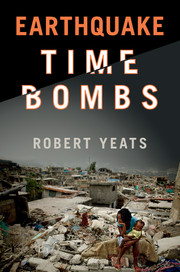Book contents
- Frontmatter
- Contents
- Acknowledgments
- Why this book?
- PART I EARTHQUAKES, DEEP TIME, AND THE POPULATION EXPLOSION
- PART II EARTHQUAKE TIME BOMBS
- TIME BOMBS WHERE THE PROBLEM IS UNDERSTOOD, BUT THE RESPONSE IS STILL INADEQUATE
- 6 San Francisco Bay Area
- 7 Los Angeles
- 8 Seattle, Portland, and Vancouver: Cascadia subduction zone
- 9 Japan: Tokyo and the Kansai
- 10 Wellington, New Zealand
- 11 Santiago, Chile
- 12 Prologue in central China
- OTHER TIME BOMBS, INCLUDING CITIES THAT ARE NOT WELL PREPARED
- PART III SUMMARY AND RECOMMENDATIONS
- References
- Index
9 - Japan: Tokyo and the Kansai
from TIME BOMBS WHERE THE PROBLEM IS UNDERSTOOD, BUT THE RESPONSE IS STILL INADEQUATE
Published online by Cambridge University Press: 05 November 2015
- Frontmatter
- Contents
- Acknowledgments
- Why this book?
- PART I EARTHQUAKES, DEEP TIME, AND THE POPULATION EXPLOSION
- PART II EARTHQUAKE TIME BOMBS
- TIME BOMBS WHERE THE PROBLEM IS UNDERSTOOD, BUT THE RESPONSE IS STILL INADEQUATE
- 6 San Francisco Bay Area
- 7 Los Angeles
- 8 Seattle, Portland, and Vancouver: Cascadia subduction zone
- 9 Japan: Tokyo and the Kansai
- 10 Wellington, New Zealand
- 11 Santiago, Chile
- 12 Prologue in central China
- OTHER TIME BOMBS, INCLUDING CITIES THAT ARE NOT WELL PREPARED
- PART III SUMMARY AND RECOMMENDATIONS
- References
- Index
Summary
Japan is the best-prepared nation on Earth against earthquakes. Earthquakes are part of Japan's cultural heritage and have even been the subjects of classical Japanese art. The first catalog of Japanese earthquakes was created in AD 900. Two subduction zone earthquakes in 1854 did great damage in the western part of the country (Figure 9.1), especially in the region between the two great population centers of Tokyo and Kyoto–Osaka–Kobe, the latter region called the Kansai.
However, by the time of the Meiji Restoration in 1868, the Japanese had decided to not just endure earthquakes and tsunamis but to do something about them. They hired foreign experts to study earthquakes, with their research centered at the Imperial University of Tokyo. The world's first professional society dedicated to the study of earthquakes, the Seismological Society of Japan, was founded in 1880; more than half of its members were foreigners. Public interest increased dramatically in 1891 after an earthquake of magnitude 8 struck western Japan north of Nagoya, with the loss of 4000 lives (Figure 9.1). Investigation of this earthquake was led by Professor Bunjiro Koto, a geologist at the University of Tokyo. Another expert was Professor Fusakichi Omori, a seismologist who, at the time of the 1906 San Francisco earthquake, was the world's leading earthquake seismologist. He participated in the Carnegie Institution of Washington-funded investigation of that earthquake.
Japan has two strikes against it. First, it is bounded by not one but two subduction zones, one extending north of Tokyo up the east coast of Honshu and Hokkaido, and the Nankai subduction zone located in southwest Japan south of the Kansai region (inset, Figure 9.1). Second, Japan is a small, crowded country, and less heavily populated regions are limited to the northern Home Island of Hokkaido.
By the early 1920s, the Japanese scientific community was taking initial steps to understand and deal with the earthquake problem, although the Japanese government and the general public were not fully involved. This situation changed suddenly on September 1, 1923, when the Tokyo–Yokohama metropolitan area (Figure 9.1) was struck by an earthquake of magnitude 7.9, resulting in 142,800 deaths and an additional 40,000 missing. The earthquake struck just before noon, when families were preparing their midday meal on charcoal stoves; the strong shaking caused fires all over the city.
- Type
- Chapter
- Information
- Earthquake Time Bombs , pp. 129 - 134Publisher: Cambridge University PressPrint publication year: 2015



